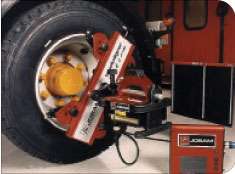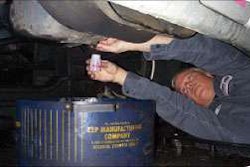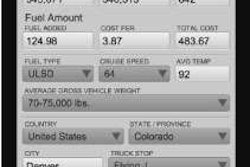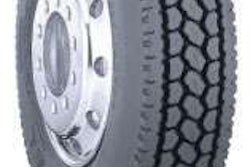
For years I’ve worked with some of the top industry experts to solve this problem. The solution requires multiple steps, but they reduce tire wear issues, increase longevity and save money.
INSPECTION. Check axles and suspension components (bushings, tie rod ends, kingpins, shocks, etc.), replacing any that show excessive wear. On the steer axle, change your shocks at least as often as you change your tires. On the drive axle, get more aggressive, replacing shocks halfway through life of the tire and when the tires are changed. I’ve recently switched to a super-premium shock, made by Road King, good for several hundred thousand miles, and then it can be rebuilt.
ALIGNMENT. If you don’t get all three tractor axles properly aligned, you’ll be fighting a losing battle. Many people believe they should get new tires installed before they have a truck aligned. The opposite is true – take your truck to the alignment shop with the old tires still on. That way, technicians can read your tire wear to learn what is wrong with the alignment and more precisely determine how to make adjustments that solve the problems. Then you can install the new tires without negatively affecting alignment.

I’m a big fan of Mike Beckett and M.D. Alignment (mdalign.com). Mike does two things very differently – he aligns the truck on the ground in the “as driven state.” Also, he doesn’t just align the truck to so-called factory specs, but rather as it should be, based on the wear of existing tires.
BEARINGS. Mike says more than 70 percent of the trucks he checks show issues with wheel bearing adjustment. Make sure your bearings are adjusted properly in all positions before going on to the next step.
 The wear of your existing tires provides valuable information that can help in adjusting alignment.
The wear of your existing tires provides valuable information that can help in adjusting alignment.MOUNTING. Don’t assume any tire was installed properly. Proper mounting, balancing and centering of each wheel and tire are key to proper wear. Many shops use some right maintenance procedures, but fail to verify proper mounting.
This is a simple check you can do. Look for a ring molded into the tire where the rim and tire meet. Measure the distance from the rim to that line at four points around the tire. Each measurement should be within 2/32-inch. If the variance is greater, the assembly needs to be broken down and re-mounted properly. If you find a shop that can do it, also have it true the tire before mounting – not all tires are perfectly round. A truing machine shaves off any high spots.
RUN-OUT. Mounting should be followed with a check of the radial run-out (deviation of the tire from a perfect circle) and lateral run-out (deviation of the sidewall from a perfect plane). Both measure how well the wheel assembly is mounted on the hub.
Good quality run-out gauges cost less than $100. Top-quality gauges cost hundreds of dollars, but they’re worth every penny. If your tire shop doesn’t have one, invest in one yourself. Problems with radial run-out are much more common than with lateral. I like to use the Tru-Balance centering sleeves to ensure proper centering of the wheel assembly and brake drum. Ideally, you want to get the radial run-out under 0.06 inch on the steer axle and 0.1 inch on the drive axle.
BALANCE. Recently I found a balancing product that has performed well. It’s a glass bead product put inside the tire during mounting. However, if the mounting, truing and centering are performed properly, you’ll find you need very little balancing.
Kevin Rutherford is an accountant, small-fleet owner and the host of “Trucking Business & Beyond,” which airs on Sirius XM Radio’s Road Dog Trucking Radio. Contact Rutherford through his website, LetsTruck.com.












